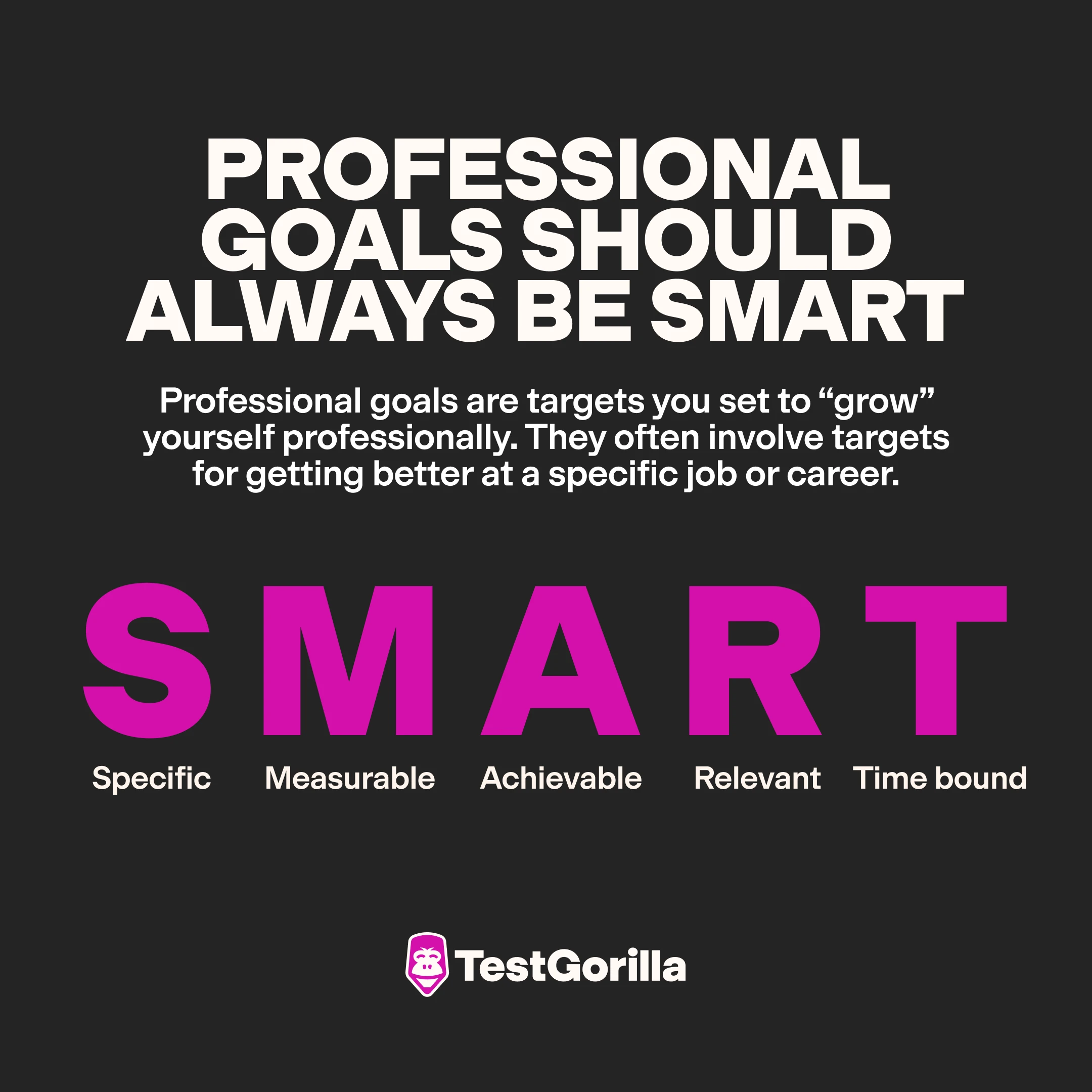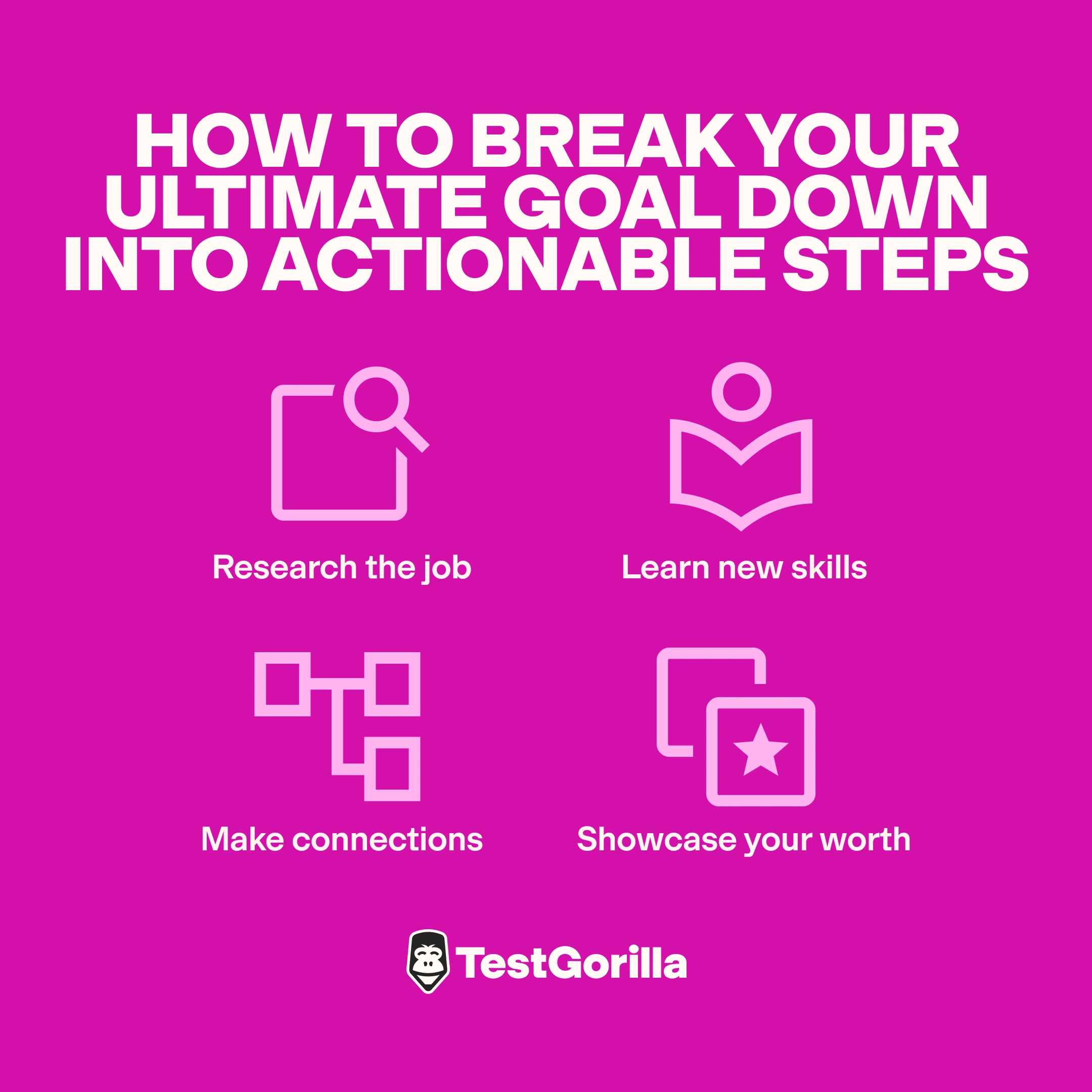Want to land your dream job? Start setting professional development goals
Finding a great job can often feel daunting, especially if you think it's out of reach or you lack the “right” degree or experience.
But did you know there are tons of employers who care more about your skills than what's on your resumes? And that getting the skills you need is totally achievable?
If you don’t have the skills you need to make a meaningful career move, professional development goals are key. They can help you identify areas for growth and create a roadmap to learning new skills. But where do you begin, and how do you make sure your goals line up with your career aspirations?
This guide will walk you through the process of setting and achieving professional goals that truly matter to you. Let’s jump right in and take the first step toward turning your career ambitions into achievable targets.
Table of contents
What are professional development goals?
Professional goals are targets you set to “grow” yourself professionally. They often involve targets for getting better at a specific job or career. They can be designed to improve your work performance, develop your skills, and take your career to the next level.
Are you a job seeker?
Visit our job seeker hub to get help with your assessment, find your dream job and more.
Employees are often asked to set goals for professional growth as part of their annual performance reviews. However, these goals aren’t just for performance reviews – you can set them whenever you want. Plus, you can use them for different purposes – including landing a great job.
SMART goals
Professional goals should always be SMART. SMART goals are:
Specific. What exactly do you want to achieve? “Increase sales” isn’t specific, but “Increase sales by 10%” is.
Measurable. Your goals should have clear, measurable indicators of success. For example, say your goal is “Get better at writing.” That goal doesn’t really have clear, easy-to-measure indicators of success. Instead, you might aim to “Read four books about writing and write seven 500-word articles.” Now that’s measurable: You can easily track if you've read four books and written seven articles. This makes it straightforward to figure out if you've met your goal.
Achievable. Is the goal achievable based on your current output? For example, you likely couldn’t run 10 miles nonstop by tomorrow if you can’t run five miles nonstop today. But you might be able to run two miles nonstop tomorrow if you can run one mile nonstop today.
Relevant. Is the goal relevant to your job and aspirations? For example, learning advanced Excel skills is relevant if your dream job involves a lot of data analysis or financial reporting. However, if you want a gig as a graphic designer, you might not need to learn these skills.
Time bound. You need to set a timeframe for achieving your goal. Making the goal time bound keeps you accountable and motivates you to achieve the goal. Simply saying “I’d like to have this completed within the next month” makes the goal time bound.
Why set professional development goals?
There are many reasons why someone may want to set professional goals. These include:
Motivating yourself. Setting job goals can motivate you to push through challenges and stay engaged with the steps you must take. When you have clear goals, you have something to work towards, which can make all the difference in staying enthusiastic and driven – even on tough days.
Improving job performance and achieving career growth. Achieving your career goals will help you get better at your current job, get better performance reviews, and achieve professional growth milestones like promotions, pay raises, or solid letters of recommendation.
Staying relevant. Industries are constantly evolving, so setting goals to keep up with these changes helps you stay adaptable and competitive in the job market.
Enhancing or learning new skills. Enhancing your current skills or learning new skills through professional goals can help you make big career moves – like achieving your desired job or successfully navigating a career change.
How to set professional development goals to get your dream job
There’s a big difference between setting professional goals for the sake of ticking boxes and setting professional goals you can actually achieve. Try following these easy steps to set professional goals and achieve your desired career move.
1. Figure out your dream job (hint: this is your ultimate goal)
First thing’s first, you need to think about which career move you want to make – because it’s going to be your overarching goal. Are you hoping for a promotion or a complete career switch? Do you want a high-paying remote job, more meaningful work that aligns with your values, or something else?
If you aren’t sure what you should be working towards, try thinking about what’s important to you. Do you dream of owning a beautiful home, working in a career you’re passionate about, or achieving a great work-life balance? Find a job that can help you get what you want in life.
By getting clarity on what you want, you'll be able to set goals that you feel passionate about achieving.
2. Break your ultimate goal down into actionable steps – and create SMART goals around those steps
You then need to break this goal down into smaller steps that you can act on. After that, set SMART goals around these steps.
So, let’s say you want to make a big career switch. Here are the steps you might take, along with some example SMART goals.
Research the job
Research the job, role, industry, or company you want to work in. This will help you determine the skills, knowledge, and other qualities you need for the role.
For example, if you want to apply for a specific role at a specific company, look at the job description advertised by the company. Or, if you don’t have a specific company in mind, look at various job descriptions for the general role you’re seeking.
The best job descriptions will highlight the skills you need for the job.
Consider using a skills-based job board like TestGorilla’s to look at open roles. You can use the job board to look at everything from customer service to sales roles. Every job description includes information about the skills you need right at the top.
For instance, a software development job might list the following skills:
Critical thinking
React
Django
CSS
Python
With these skills in plain sight, you can easily figure out which skills you have and which skills you need.
Example SMART goal: Say you want to switch into a software development role. Your goal might be to spend two weeks researching fullstack development job descriptions on various job boards – including TestGorilla’s job board – and coming up with a list of the top skills employers seem to want. You can use this info to determine the areas where you need to develop.
Learn new skills
Based on your research, which skills, knowledge, experience, and other qualities do you need to land your dream job? Which areas do you need to develop? Your next step might involve filling any skill or knowledge gaps you have.
To do this, you’ll likely need to seek out training, education, or experience. Look into classes, certification programs, or entry-level positions or internships. Take on personal projects and read books. There are so many options available, and many of them are free!
Example SMART goal: Let’s say you need to learn React and Django to land your desired role. Your goal could be to register for and complete an online coding bootcamp to learn these frameworks in six months. This way, you can learn what you need to fill your skills gaps.
Make connections
As you’re gaining the skills you need for your desired role, your next step might be to start building connections with people in the industry or company you want to move to. You could form relationships through social media or conferences, for instance.
Example SMART goal: One goal might be to send LinkedIn requests to the hiring managers for at least three companies you want to work for. You can develop a rapport and express interest in the companies’ open roles. This way, you’ll be on the hiring managers’ radar.
Showcase your worth
One of your final steps might be to find ways to showcase your skills to potential employers. You might build portfolios, add to open-source projects (like GitHub repositories for programmers), or take assessments, for example.
Example SMART goal: One way to showcase your worth might be to spend three months creating a portfolio website featuring the apps you’ve built using React and Django. You can link prospective employers to this site when you apply for jobs.
Pro tip: If you apply for jobs through TestGorilla’s job board, you’ll be asked to take assessments as part of the hiring process. For example, if you apply to be a software developer that lists React as one of the needed skills, you’ll be asked to take a React Online test as part of an assessment. This will give you the opportunity to show that you understand the React framework – and can handle the job.
Why are skills so important to getting your dream job?
Reskilling and upskilling – getting new skills or enhancing your existing skills – are key to scoring your dream job because skills are what equip you to actually do the work well. Without the right skills under your belt, you’ll flounder in the position.
Many modern-day employers know this – and that’s why so many of them are using what’s called “skills-first hiring.” This means that they consider each candidate’s skills before they consider other things (like college degrees or experience). After all, they want to hire someone who can do the job well.
Luckily, skills-first hiring unlocks career opportunities and other big career moves. We surveyed thousands of candidates and employees, and here’s what they had to say:
Eight-six percent say they’re more likely to land dream jobs when they’re given the chance to prove they have the right skills for the role.
Sixty-six percent say they’ve landed new jobs by taking skills-based assessments.
In other words: skills-first hiring works in your favor – especially when it comes to landing that great job.
Take skills-based assessments – and land your dream job – with TestGorilla
Upskilling is your golden ticket to achieving your dream job. But, you can’t magically change your skill set overnight. That’s where setting goals for professional development comes in.
Setting and achieving your professional development goals can help you attract the attention of prospective or current employers. This is especially true if those goals help you level up your skills.
If you’ve upskilled – and are ready to start looking for your dream job – consider using TestGorilla’s job board. Check it out, see if any jobs pop out at you, and simply ask to be invited to take the assessments for those roles.
That’s right – you take the assessment first before doing anything else. This means you don’t need to waste time on cover letters or resumes – you can use your newfound skills to find your new job now.
Related posts
You've scrolled this far
Why not try TestGorilla for free, and see what happens when you put skills first.
Latest posts
The best insights on HR and recruitment, delivered to your inbox.
Biweekly updates. No spam. Unsubscribe any time.

Skills tests to hire the best
Our screening tests identify the best candidates and make your hiring decisions faster, easier, and bias-free.
Free resources
A step-by-step blueprint that will help you maximize the benefits of skills-based hiring from faster time-to-hire to improved employee retention.
With our onboarding email templates, you'll reduce first-day jitters, boost confidence, and create a seamless experience for your new hires.
This handbook provides actionable insights, use cases, data, and tools to help you implement skills-based hiring for optimal success
A comprehensive guide packed with detailed strategies, timelines, and best practices — to help you build a seamless onboarding plan.
This in-depth guide includes tools, metrics, and a step-by-step plan for tracking and boosting your recruitment ROI.
Get all the essentials of HR in one place! This cheat sheet covers KPIs, roles, talent acquisition, compliance, performance management, and more to boost your HR expertise.
Onboarding employees can be a challenge. This checklist provides detailed best practices broken down by days, weeks, and months after joining.
Track all the critical calculations that contribute to your recruitment process and find out how to optimize them with this cheat sheet.

















